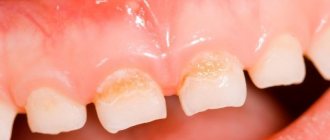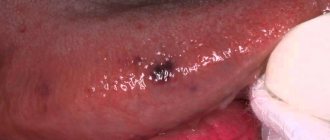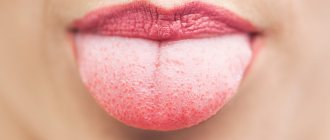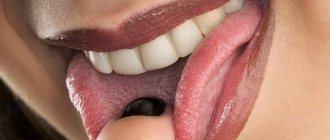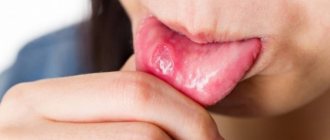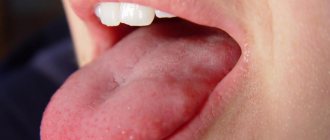A bruise on the tongue is not only unpleasant, but sometimes also very painful. But the worst thing is that upon discovering it, a person invents an incredible illness for himself and becomes emotionally unbalanced. And this can already lead to much more serious consequences. But is a hematoma on the tongue really not dangerous, or can there still be a reason for nerves?
What you need to know about the oral mucosa
The tongue and the mucous membrane around it have 5 main functions. Namely:
- protection;
- suction;
- selection;
- thermoregulation;
- taste perception.
It is the protective function that “monitors” that the negative influence of the environment does not cause harm. But we are talking not only about various viruses and microorganisms, but also about mechanical damage. The mucous membrane withstands irritants of all types: from mechanical to temperature and chemical.
Interesting! The mucous membrane of the mouth is endowed with the fastest regeneration.
Often, it is by the mucous membrane that the doctor can determine whether there are serious disturbances in the body’s functioning or not. Most diseases leave their mark on its condition, for example, in a patient with diabetes mellitus, the tongue will be red, with cracks and erosion. Therefore, any changes in the tongue, and especially a bruise, should cause an urgent visit to the clinic.
Hematoma on the tongue: causes
There are three reasons for a bruise on the tongue. If you determine the main one, the doctor will be able to prescribe competent treatment and the problem will disappear in the near future. Among the probable causes of hematoma, the following are worth highlighting.
- Injury to the mucous membrane by mechanical impact on it. Most often, the notorious fish bones and seed husks are to blame.
- Chemical burn. We are not talking about dangerous reagents, but the whole point is overly salted or spicy food. Pepper and salt irritate the delicate mucous membrane, thereby injuring it.
- Thermal exposure is a sip of scalding tea or an ice-cold drink. Most often, they provoke the appearance of hematomas on the tongue.
Type of hematoma based on fluid color
Even before going to the doctor, you can determine the degree of injury and the duration of wound healing based on the color of the liquid in the hematoma. The content may be as follows:
- a milky white tint indicates that the wound is of a superficial type, where the vessels were not affected. There is no blood in the ulcer, only serous fluid. Such injuries heal the fastest;
- red color indicates a fairly deep injury; it is possible that a muscle is affected. Such wounds take longer to heal, the reason being that the blood is much more difficult to absorb. What complicates the situation is that this environment is attractive to various types of microorganisms. It's no secret that the mouth is the dirtiest place in the body. It is in the oral cavity that contains a large number of microorganisms that can cause inflammation.
If the blood bruise is located on the side of the tongue, then this may be a symptom of a dangerous disease: stomatitis, problems with the gastrointestinal tract, disruptions in the endocrine system. This is why you should not put off going to the doctor.
Diseases accompanied by a blood bubble on the tongue
Stomatitis
With various types of this pathological condition of the oral cavity, blood sacs can also form on the inside of the cheeks, on the gums, palate, and tongue. Stomatitis is caused by pathogenic microorganisms (bacteria, viruses, fungi), a weakened immune system and injury.
Often this disease is of herpetic nature. Associated symptoms are swelling of the tongue, the presence of a yellow-white coating on it, wounds that cause severe pain and discomfort while eating and speaking.
If the disease is caused by the herpes virus, then it is accompanied by the presence of a large number of blisters on the surface of the tongue, which after some time combine into one blister.
When it bursts, erosion forms in its place. In addition to these manifestations, body temperature may rise, weakness, malaise, and loss of appetite may appear.
Syphilis
In this pathological condition, a characteristic feature is the presence of syphilitic chancre on the surface of the tongue; they are an ulcer or erosion that has a round shape.
The edges of the chancre are uniform, smooth, and the bottom is hard, from which liquid flows out when pressed.
Their sizes can vary from 1 mm to 2 cm.
There are ulcers on the tip, back of the tongue or on its lateral surfaces. The person does not feel pain or discomfort.
2-3 weeks after the occurrence of such ulcers, an increase in regional lymph nodes occurs.
Cancer
This disease, which has an ulcerative form, occurs with the formation of wounds on the tongue with a black bottom, which have unclear edges and blood oozes from them. The location is the edges of the tongue and its tip.
Obvious signs of this disease are pain, discomfort in the oral cavity, a putrid odor, swelling of the face and neck, difficulty swallowing, talking, and chewing.
Tuberculosis
After Mycobacterium tuberculosis enters the human body through the mucous membrane, ulcers appear at the site of the lesion. They can form on the tongue, lips, gums, cheeks, and palate. Externally, the ulcer looks like a pink crack, covered with a white-yellow coating, its edges are soft and scalloped.
If you try to remove the plaque, its granular bottom begins to bleed. In most cases, yellow-red bumps form around the affected area.
With tuberculous ulcers, pain, discomfort in the oral cavity, and difficulty eating and speaking are noted.
The healing process of wounds occurs quite slowly. When palpated, regional lymph nodes cause severe pain and are enlarged.
Necrotizing periadenitis
With this disease, there is increased salivation, bleeding, and foul odor from the mouth.
In a recurrent condition, the ulcers are localized on the side; they affect not only the tongue, but the lips and cheeks.
Before they form, the mucous membrane thickens, the edges at the site of the lesion rise.
Inside the ulcers there is an inflammatory infiltrate, which contains blood, lymph, and cellular accumulations.
With this disease, there is increased salivation, bleeding, and bad odor from the mouth.
In advanced forms, the ulcers deepen and fill with purulent contents, which provokes increased body temperature, a feeling of weakness and poor health.
They are very painful and very difficult to cure. This period can last several months. Treatment here must have a comprehensive approach.
Afty Bednary
This pathological condition most often affects small patients under 1 year of age who are bottle-fed or breast-fed. Aphthae can form due to excessive pressure on the nipple or when using an uncomfortable bottle.
After some time, they turn into ulcers covered with a gray-yellow coating, which is quite problematic to remove. The inflammatory process occurs with a change in color, the aphtha has a red color and swelling appears around it.
Given the severe pain that is characteristic of such ulcers, the child refuses food and begins to be capricious, which is easy to notice. Aphthae can also appear on the tongue, cheeks, and gums in older children as a result of constant sucking of hands, fingers, and toys.
Endocrine pathologies
If there is an acute shortage of nicotinic acid, then there is an increase in the size of the tongue, a dense coating on it, and the presence of furrows.
In diabetes mellitus, due to trophic changes in the tongue, decubital wounds appear, filled with a dense infiltrate in the center.
They heal very slowly and cause a person a lot of unpleasant sensations. The tongue becomes red and swells.
Gastrointestinal diseases
Blood blisters on the tongue, under it, are formed due to disturbances in the functioning of the gastrointestinal tract. Thus, ulcerative glossitis can develop with enterocolitis and hypoacid gastritis.
Worm infestation
Ulcers with a white-yellow coating, hyperemia of the tongue, its swelling, severe pain, increased salivation, bad breath may indicate the presence of parasites in the human body.
Hypovitaminosis/vitaminosis
With a lack of vitamin A, a person complains of a feeling of dryness in the mouth, which leads to the formation of cracks and ulcers on the surface of the tongue.
If there is an acute shortage of nicotinic acid, then an increase in the size of the tongue, a dense coating on it, and the presence of furrows are observed.
When removing plaque, irritation of the mucous membrane occurs, which causes discomfort and pain in the affected area. In case of vitamin C deficiency, blood vessels become fragile and blisters form when they rupture.
The papillae may atrophy, the tongue acquires a folded structure, and ulcers appear on its surface. Such manifestations on the tongue are characteristic of a lack of vitamin B6.
Correct treatment
Eliminating the cause means curing the disease faster. This statement is truer than ever. But only if the cause is not a serious illness. It is clear that large hematomas take longer to disappear than small ones. Despite this, even a tiny bruise can be a reason to go to the clinic. The fact is that in order to avoid serious consequences, surgical intervention is sometimes necessary, during which the hematoma is removed. When contacting a doctor, it is better to choose an oral and maxillofacial surgeon.
In order for the hematoma to go away faster, you need to maintain oral hygiene, namely:
- brush your teeth after and before bed, and preferably after every meal;
- if you cannot brush your teeth after eating, chewing gum can perform hygienic cleaning, removing food particles;
- Rinse your mouth with antiseptic solutions several times a day.
It must be said that only the attending physician prescribes treatment methods for a bruise. True, most often it is the most common and is based on rinsing. Only if the hematoma grows or conservative treatment fails, something more serious is used.
Causes
Among the factors that provoke various external damage to the oral mucosa are:
Mechanical
Injury to the surface of the tongue is caused by all piercing and cutting objects that cause direct and instantly noticeable harm.
For example, dishes with bones cause damage to the oral mucosa during consumption. It is not the amount of food eaten that matters here, but the receipt of microtraumas that violate the integrity of the surface of the tongue.
Blood blisters that form due to mechanical action do not pose any threat to human health. To speed up the process of resorption of seals on the tongue, under it, it is recommended to rinse the mouth more often after eating.
Chemical
The duration of wound healing from thermal exposure directly depends on the depth of the lesion; they heal for quite a long time
When eating salty or sour food in the mouth, small lesions in the form of ulcers appear almost instantly on the mucous membrane of the tongue.
This reaction is observed among most fans of oriental cuisine, where hot seasonings are used.
Thermal
Such damage includes microtraumas resulting from drinking too hot tea or coffee.
The duration of wound healing from thermal exposure directly depends on the depth of the lesion; they take quite a long time to heal.
Depending on the degree of damage, sensations change:
- In the first degree, the burn occurs only on the outer layer of the tongue. A person experiences pain, the color of the tongue changes to red and after some time begins to swell. Rinsing the mouth with antiseptic solutions will help speed up the healing process.
- In the second degree , the sensations become more painful, since not only the outer but also the inner layer of the tongue is affected. The formation of blood blisters, swelling of the tongue and its redness are also observed. In this case, it is recommended to seek medical help as soon as possible so that the doctor removes the lump, washes the affected area and treats it with an antiseptic.
- In the third degree, the burn penetrates deep into the tongue, the burned surface becomes black. The patient complains of a feeling of numbness of the tongue and severe pain. The help of a doctor is mandatory here, otherwise there is a high probability of death.
Useful tips
Found a hematoma in your mouth? It would be helpful to do the following:
- give up irritating foods: salty, smoked, spicy, etc.;
- rinse your mouth with antiseptic drugs;
- make an appointment with a doctor and be sure to visit him if hematomas appear;
- adhere to medical recommendations.
In addition, when identifying a hematoma on the tongue (blood or regular), you cannot:
- pierce it so that it heals faster (you must remember that it is easy to get an infection into the wound);
- injure in any other way;
- refuse to go to the doctor in the hope that everything will go away on its own;
- panic and invent dangerous diseases and their symptoms.
What not to do?
If you have blood blisters, you should not:
- Pierce and burst them yourself. This technique will only worsen the situation; as a result of additional injury, a fungal infection will join the existing problem, which will prolong the disease.
- Ignore the hematoma, lump, or clot that appears in the oral cavity. If there are any changes in the mucous membrane of the tongue, gums, palate, or cheeks, it is recommended to contact a qualified specialist who will identify the true cause of the disease and prescribe an appropriate treatment regimen.
Dangerous consequences
The most common complication that can occur as a result of a hematoma is infection in the wound . If you do not pay attention to this in time, an inflammatory process begins, accompanied by fever, increased temperature, weakness, loss of consciousness and other dangerous symptoms. Moreover, this can harm not only the oral cavity, but the entire body. Although most often, as a result of a bruise, a person simply loses his sense of taste and appetite. It must be said that if the above symptoms are accompanied by numbness of the tongue or jaw and speech impairment, then you need to urgently call an ambulance or go to the clinic yourself.
Most often, bruises occur on children's tongues. Kids are in a hurry, play around, bite themselves or get injured, for example, with a fork. True, adults are not protected from such damage either. Be that as it may, everyone in such situations needs to consult a doctor, and then adhere to the above treatment recommendations. Then the bruise will disappear in a matter of days and without complications.
How to treat a blood bladder?
General therapy
Depending on the type of pathological condition that caused the appearance of a blood bubble in the mouth, treatment can be carried out with the following medications:
- In case of traumatic formations that go away on their own over time, the oral cavity is treated with antiseptic agents
For candidal stomatitis, antifungal drugs such as Levorin and Nystanin are effective.
- For diseases of viral etiology, the treatment regimen includes Viferon, Amoxicillin, Tsiprolet, Azithromycin.
- To combat gingivostomatitis, where it is expected to remove areas affected by necrosis, antiallergic medications, antibacterial agents, and vitamin complexes are used.
- In case of traumatic formations that go away on their own over time, the oral cavity is treated with antiseptic agents. If there is pain, the doctor may prescribe Cholisal, Ketoprofen, Voltaren, Lornoxicam, Kamistad.
- To eliminate tuberculosis, appropriate chemotherapy is prescribed, which includes Rifampicin, Ioniazid, Pyrazinamide.
Local therapy
To speed up the healing process, regularly rinse with antiseptic agents. Furacilin, Chlorhexidine, Stomatidine, Betadine, Miramistin, hydrogen peroxide solution, Iodoform, Chlorophyllipt show good results.
Treatment of the affected tongue with disinfectant solutions should be performed twice a day, at a minimum, but before that you must brush your teeth and remove any remaining food.
It is advisable to eat food after the procedures within 30-60 minutes, which will significantly increase their effectiveness.
Traditional methods
Aloe or Kalanchoe juice has a wound healing effect
To alleviate the condition, it is good to use healing decoctions based on chamomile, sage, yarrow, St. John's wort, and viburnum fruits.
They are prepared at the rate of 1 tbsp. herbal raw materials per 1 glass of water.
The mixture is brought to a boil and left for 2-3 hours to infuse. Before use you need to strain.
Aloe or Kalanchoe juice has a wound-healing effect.
Oil from sea buckthorn and rosehip also has the same property. They are applied directly to the affected area.
These agents accelerate the regeneration process, prevent the proliferation of pathogenic microorganisms and anesthetize the lesion.
A solution prepared from salt (1 tsp), 3 drops of iodine and soda (1 tsp) is a universal remedy in the fight against inflammatory processes in the oral cavity.
These components are mixed in one glass of warm boiled water and used for lotions and rinses. It is also good to treat the affected areas with hydrogen peroxide.

